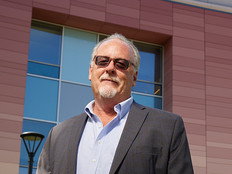Every Step You Take
Today’s IP camera systems can put one person, sometimes miles away, in charge of an entire school’s security.
There are 30 entrances across the sprawling campus of Taos High School. Serving 900 students in Taos (N.M.) Municipal Schools, the school was built in stages over the years, with new halls and a building added as the student population grew.
Even in a relatively quiet town, keeping tabs on who could get into the school and what was happening around campus was beginning to feel like trouble. “The way the campus was built, there was no thought to security,” says Robert Spitz, the district’s tech coordinator and network administrator.
After several years of lobbying by Spitz, the school board approved the purchase of 100 IP video cameras in the spring to bolster security throughout the school district. “Once you see how they work with the software on a PC, you see how one person can watch the whole school,” Spitz says.
Compared with closed-circuit TV systems in years past, the new IP cameras are generally less expensive, easier to install and more flexible to operate. The cameras connect via Ethernet cable to a school or district’s network, using either out-of-the-box or specially designed software that allows monitoring from a standard PC, with images stored on a server.
Stopping Trouble
For the past five years, Spitz has had a few IP security cameras installed in his department office — he even caught a potential thief on camera two years ago — and he agrees that the latest technology is much improved. Unlike analog security cameras, digital cameras don’t need special cables and power for each camera. “I just run a Cat 5 [cable] to where the camera is going to be. It gets power off the Ethernet cable, so I just plug it in and off you go,” Spitz says.
The ease of installation also allows Spitz’s department to add more cameras when convenient to their sometimes hectic schedules, an important consideration when maintaining more than 2,000 computers on six campuses. Spitz and the facility’s principal walk through the building together to determine where to put the cameras. Spitz estimates that about 60 percent of the consideration is nighttime and weekend security, with the remaining 40 percent for maintaining order during the day; when kids know that the school can review the files to identify perpetrators, they’re less likely to start trouble in the first place.
“School technology can be a great help to school safety,” says Kenneth Trump, the president of National School Safety and Security Services. “Security personnel, the administration and the IT people need to get together to get on the same page when considering how a system will be installed and used,” he says. “But IP cameras are a trend and the direction that many schools are starting to go.”
Specific Needs, Specific Answers
The flexibility of the new generation of IP cameras has also been a major advantage for Frederick County (Va.) Schools. Two of the district’s high schools had an analog system in the past, but with the construction of a new high school, the district made the move to IP cameras. Two hundred of a planned 250 districtwide are already installed.
“The beauty of the IP system is, for example, that if a school tells me they want one over the front door, I can just drop a camera in. We wouldn’t have been able to do that before. The maintenance department would have had to run power and wire the cameras,” says Joel McKenzie, the district’s coordinator of technical services. “It’s easy for us to add new sites even as the current ones are running.”
The variety of camera features has also been useful. In the hallways, the district usually installs the Axis 211, which can deliver Motion JPEG and MPEG-4 video streams simultaneously. IQ and Envision models that provide higher resolution are used to cover larger areas, such as a lunchroom. And wireless models at a high school baseball field’s press box were installed to cut down on vandalism, sending the signal to a wireless bridge on the school’s roof.
An Ethernet LAN connects all 18 schools and several administrative buildings in the district, and McKenzie has all camera data traveling on a virtual LAN. “It keeps the traffic from the cameras separated out so the data devices don’t have to listen to it,” he explains. The feed goes to the superintendent’s office and other PC stations, such as the offices of the sheriff’s deputies who are assigned to each of the district’s high schools and middle schools.
With four frames per second of recorded video (compared with about one frame every four seconds with the old analog system), the district’s IP video cameras produce enough data that Frederick County Schools had to determine how to handle backup. Now, for every 60 cameras the district installs, McKenzie adds a server to handle data storage, which allows the district to keep the archives for about four weeks until it is overwritten with new data.
Sudden Impact
The IP cameras already have had an impact on the schools in Frederick County. McKenzie says the district does not have data on how the cameras have affected discipline in the district, but digital evidence has changed how some issues are resolved. “We’ve had some vandalism and fights that have been recorded on camera, and it made the investigation go a lot faster,” McKenzie says. “There have been times when parents didn’t believe their child could do what they were accused of doing, but we can show a video to prove our point.” In general, parents haven’t had any problems with the introduction of the video systems, he adds.
Even better than the recording of incidents is the cameras’ ability to keep them from happening at all. McKenzie says that there has been a definite drop in graffiti and other similar problems. After-school programs and other outside groups use some of the schools’ facilities outside of school hours, and the school bus fueling station attracted unwanted attention over the years.
“Sometimes there would be damage done,” McKenzie says, “but since we’ve put in those camera monitors, it seems like everywhere we’ve put one, the problem has gone away.”
The Chicago Connection
In March, Chicago’s Mayor Richard M. Daley announced the city’s police, fire and emergency management departments would have access to the real-time video feed from all security cameras at Chicago Public Schools. With more than 4,500 cameras currently inside and outside about 200 CPS elementary and high schools and administrative sites, Chicago becomes the first city in the nation to have such an integrated system.
About half of the CPS sites had been connected to the city’s Office of Emergency Management and Communications by the end of May, a quick turnaround made possible because the department had already undertaken a similar connection to several private-sector systems, according to the city group’s acting executive director, Jim Argiropoulos. The rest of the CPS cameras are expected to be linked by early 2009, which will require the department to support both digital and analog systems and a variety of software management systems.
Real-time images from the CPS cameras are accessible in the city’s $5.5 million command and control center, which includes a 28-foot video wall and 15 work stations, and the feed can be sent to mobile command stations via satellite for police, fire or disaster personnel onsite at a school in the event of a situation that warrants an emergency response. Argiropoulos says the operational procedures are as important to the project as the technical connectivity, noting that his department has regular forums with city schools, both to answer questions and to give advice on how to best use cameras for security purposes.
“Every day we run specific video missions, utilizing various cameras from the schools, from private providers and our own system at specific locations,” Argiropoulos says. “For example, we’ll have our eyes out when a school lets out. All this is for the betterment of the city and its residents.”
Candid Camera
With security cameras increasingly common in every type of school, it’s inevitable that some amazing things are going to be captured.
Bad Idea
In what apparently was a post-graduation prank, a handful of students were caught on camera in the middle of the night in June pouring two gallons of vegetable oil in the halls of Eustis High School in Florida and then letting loose two goats.
Gone With the Wind
The power of a tornado rolling through the Missouri town of Caruthersville this spring was captured by a couple of security cameras at the local high school, which lost a roof to the twister.
A Sad Day
Perhaps the most infamous school security camera footage is from the 1999 killings at Columbine High School, which shows the student killers and some of their victims in the halls and cafeteria of the school during the massacre.
Kiss and Tell
A clandestine kiss between two girl students caused an uproar last year at Gig Harbor (Wash.) High School when the dean of students saw the incident on camera and subsequently showed one of the girls’ parents the footage.







